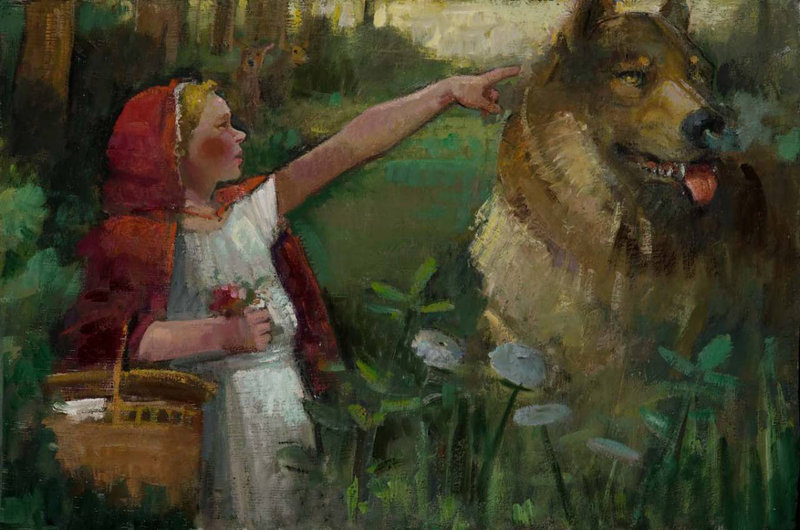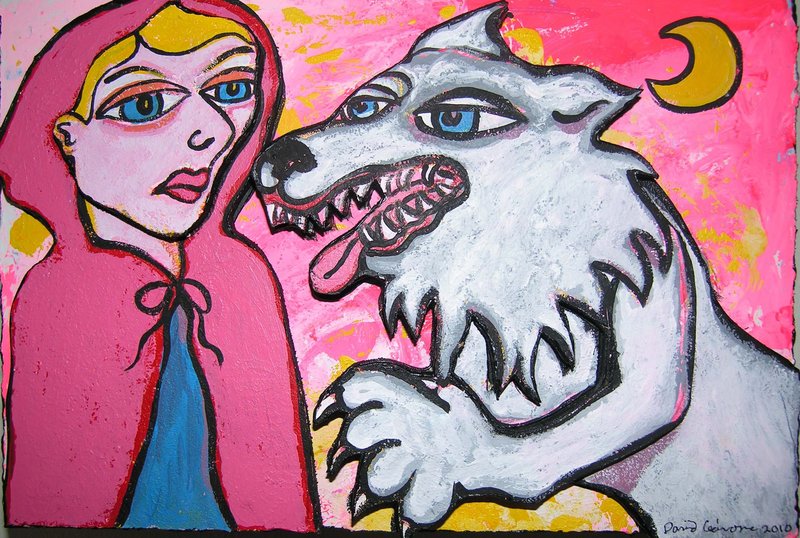The irony of poetry is that it must be presented literally verbatim for its rhythms, forms and gestures to fairly unfurl their complexity and subtly colored content.
Stories, on the other hand, are the stuff of prose — so any retelling is valid.
Nancy Morgan-Barnes’s painting “Little Red Riding Hood,” now on view in Greenhut’s side gallery, however, is a poetic presentation of a story.
Despite the myriad versions of the fairy tale, Morgan-Barnes’s Red Riding Hood fits the Brothers Grimm’s without problem: The apple-cheeked and creamy-skinned heroine is pointing toward Grandma’s house and explaining her venture to the boldly handsome wolf. But Big Bad is lost in dastardly scheming: He stares off distractedly while smoke drifts up from his nostrils. Two deer watch from afar — rightly concerned but too timid to act.
The painting is gorgeous in every way. Morgan-Barnes paints beautifully and builds up unusually luscious surfaces — painted, scraped, sanded, glazed and finally varnished. Her technique, patience and craftsmanship deliver something rarely seen since the 19th century, and it fits perfectly with the Victorian feel of her compositions.
David Cedrone’s show at Coffee Design also features a Red Riding Hood — but it could hardly be more different. Cedrone paints in a loose and happy cartoon style that is wholly dedicated to legibility and simple fun. Instead of telling the story, Cedrone’s version is like a portrait of the odd pair — not in action, but self-consciously posing.
Cedrone’s works strike a cheery and immediate impact: We recognize Red and Big Bad, but we aren’t challenged to figure out where they are in the story. Just as Morgan-Barnes’s complex density insists on a slower reading or poetic parsing, Cedrone’s theatrical cartoonishness matches the bright immediacy of his subjects.
(Cedrone’s “Red Riding Hood” was sold, however, so it will likely not be on view by the time this is published. Considering most of the 45 or so works on display are terrific and priced around $100 each, I wouldn’t be surprised if he sold them all.)
Because of its recognizable narrative, Morgan-Barnes’s Red Riding Hood is an exception to her works at Greenhut. The others all play on the idea of narrative, but their stories — even if they seem familiar — aren’t already known to us. They feature assorted bugs, birds, plants and animals sometimes in clear action and sometimes not.
In “An Amoral Fable,” an adorably animated little turtle frolics with a butterfly, who may or may not be aware she’s leading him to the edge of a cliff. A lightning-darkened sky hints this isn’t going to work out so well for him.
In “The Discovery of Fire,” a troop of ants comes upon a crushed but still burning cigarette butt. The immediate landscape is lushly alive with flowers, plants and industrious creatures, but a steely industrial landscape looms in the evening distance. While there is a sense of foreboding to this work, it’s a brilliantly witty meditation on perspective and the idea that to social creatures come stories and culture — and that progress is not always a positive thing.
What makes Morgan-Barnes’s paintings exceptional (besides their incredible technique) is their narrative sense of possibility. While Cedrone is a master of cartoon prose, Morgan-Barnes is a poet of deliciously dense and sophisticated complexity. In her hands, narrative is a wellspring of possibility, like the unlimited imagination of a child looking at fairy tale illustrations of stories he has yet to learn.
A terrific contrast is the strong landscape work of Kathleen Galligan also now on view at Greenhut. (While I prefer her elegantly masterful pastels, this show proves she can also handle oil paint quite well). Galligan reminds us that landscape is about a sense of place, a here and now experience of the then and there: time and place without story.
The contrast with Galligan seems to reveal why Morgan-Barnes’s most unsettled concern in her new paintings is their spatial sense: Her works set in open landscapes breathe easily, but her denser compositions can be somewhat claustrophobic because of their more stage-like theatricality. However, she seems to be just settling into this new series, so we’ll simply have to give her space and see if Morgan-Barnes follows her surrealist inclinations, her witty plays on allegory and morality tales, or her quirky transmutation of children’s stories.
Whatever comes next, I have no doubt it will also be great.
Freelance writer Daniel Kany is an art historian who lives in Cumberland. He can be contacted at: dankany@gmail.com
Send questions/comments to the editors.



